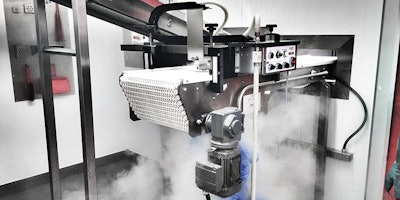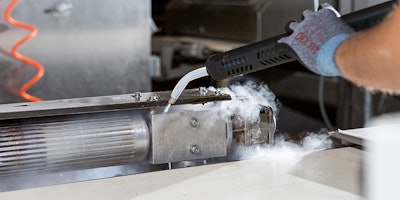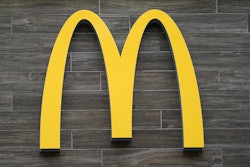
 Evan Reyes
Evan ReyesThe Food Safety Modernization Act (FSMA) hit food facility sanitation teams hard. Many sanitation managers struggle to comply with increasingly stringent food safety standards, often with fewer workers. Over the years, it has become increasingly common for sanitation departments to be downsized to keep food prices down and competitive, while food safety standards are increasing.
Extra cleaning and sanitizing challenges plague dry processing facilities, such as those making bakery items, snack foods, confections, dry ingredients, powered drink mixes, seasonings, coffee and dry pet food. There is zero tolerance for moisture in certain facilities, so standard wash-down methods aren’t an option.
Traditional ways of cleaning conveyor belts in dry environments have often involved completely removing conveyor belts and moving them to a wash-down area for cleaning. For in-place cleaning, teams may use scraping, brushing, wiping, vacuuming techniques and compressed air. However, these methods are often slow, labor-intensive and potentially dangerous for workers.
As a result, processors have increasingly been turning to dry steam sanitation as a more effective method to clean in water-sensitive environments. Dry steam sanitation uses the power of high-temperature, low-moisture dry steam for cleaning food processing equipment, conveyor belts and other industrial machinery. The high-temperature dry steam obliterates fats, oils, dirt and seasonings, and kills mold, bacteria, listeria and other microorganisms on contact. The dry steam evaporates quickly, leaving minimal moisture behind, resulting in clean and dry surfaces.

Food safety regulations will continue to get more stringent, but processors often can’t afford to add more labor. The best way to stay competitive and compliant is to invest in cleaning and sanitizing technologies that get the job done more effectively and improve the company food safety program.
Several new food trends have also created new challenges for processors and their cleaning processes:
Snack Bars
Sales of snack bars are on the upswing. According to Mordor Intelligence, the global snack bars market is expected to grow 6.7 percent over the next five years. As consumers look for more nutritious, functional snacks, bars are good on-the-go options. Many consumers want lower-sugar options, so bar manufacturers are turning to more natural ingredients for sweetening and binding, such as dried dates, cranberries, cherries, raisins and other dried fruits.
Dried fruits are sticky and cause an extra problem for cleaning conveyors. In this application, dry steam cleaning provides the power to remove residues without introducing moisture, so processors can maintain sanitary conditions without shutting down a line for a wash-down with water.
Allergens
Now more than ever, consumers are aware of food allergens such as dairy, soy, eggs, tree nuts and peanuts. Therefore, processors are pressed to take extra precautions with thorough cleaning during allergen line changeovers. In addition to complying with FSMA’s stringent allergen standards, processors are vulnerable to legal action and recalls if there is even slight cross contamination of allergen ingredients.
A potential source of allergen cross-contamination is when particles become airborne during cleaning with compressed air, vacuums, hand wiping or pressure washing with water. In addition to moving allergens, these cleaning methods can also blow mold and microorganisms from one part of the facility to the other.
To avoid such problems, the best solution for flat belt cleaning is a combination of dry steam and vacuum extraction. A dry steam cleaning system affixed to a conveyor will run dry steam and immediately follow with an industrial HEPA filtered vacuum as the conveyor goes by, providing a clean, dry and sanitized surface in one pass and without migration of particles down to the micron level.
Gluten-Free
Whether diagnosed with celiac disease or not, more consumers seek gluten-free foods. Statista forecasts that the North American gluten-free market will reach 3.9 billion U.S. dollars by 2020, which is up from 2.4 billion dollars in 2015.
To replace gluten, processors may use a combination of starches, gums, proteins and gluten-free flours. These new formulations can create different textures in a product. For example, alternate flours can produce a thinner bread dough mixture than a standard bread formulation with gluten. Often gluten replacement ingredients create a stickier product, which can leave residue behind and be more difficult to clean off of a conveyor.
The common and most labor-intensive way to clean sticky residues is to stop the line, disassemble the conveyor and remove food-contact surfaces to clean in a wash-down room. This can take many hours of downtime. The next step, hand wiping sticky residues can also take a long time and create the potential for repetitive movement injuries. The most efficient way to clean sticky residues on a conveyor in dry environments is to use dry steam cleaning.

Ready-to-Eat
The average family seems to have little time for food preparation, which makes ready-to-eat (RTE) foods an easy choice. According to a USDA Economic Research Service study, RTE foods are especially popular among Millennials. This trend can be illustrated by the store’s deli section which has grown from a simple meat counter to cases of RTE options such as sandwiches, salad bars, meats, cheeses, party trays and a wide variety of fresh snacks. These items are at a higher risk of bacteria and other contaminants because there’s no at-home cook step to kill them. As a result, RTE facilities have much more stringent sanitation requirements through FSMA.
Steam cleaning is a good supplemental tool to help ensure food safety standards are met in a high risk RTE wet cleaning environment. Dry steam cleaning can be done quickly and with minimal worker involvement.
Environmental Friendliness
When consumers read food labels, they aren’t just looking at nutrition information. Any environmentally friendly claims can help differentiate one brand from another. Food processors can benefit from having more sustainable practices in the manufacturing process. Compared to wet cleaning, a dry steam cleaning process significantly reduces water consumption and resulting wastewater by up to 95 percent. In addition to having a lighter impact on the environment, reducing water use is a good business practice because it saves on costs related to water utility, electric power to move the water and wastewater fees. However, dry steam can replace wet cleaning completely, only in specific applications.
A hand-wiped pieced of equipment in a dry processing plant will still require a spray down to sanitize at acceptable levels. Dry steam cleaning reduces the need for these chemicals, which saves money and provides an opportunity to demonstrate environmental responsibility to consumers.
Dry steam cleaning is growing in popularity as processors seek better ways to meet sanitation requirements in environments that can’t tolerate water, have allergen changeovers or have a higher risk for contamination. Consumer tastes and preferences may change, but dry steam cleaning is ready to handle the most challenging cleaning applications for food processors.
Evan Reyes is National Account Manager at Goodway Technologies.






















